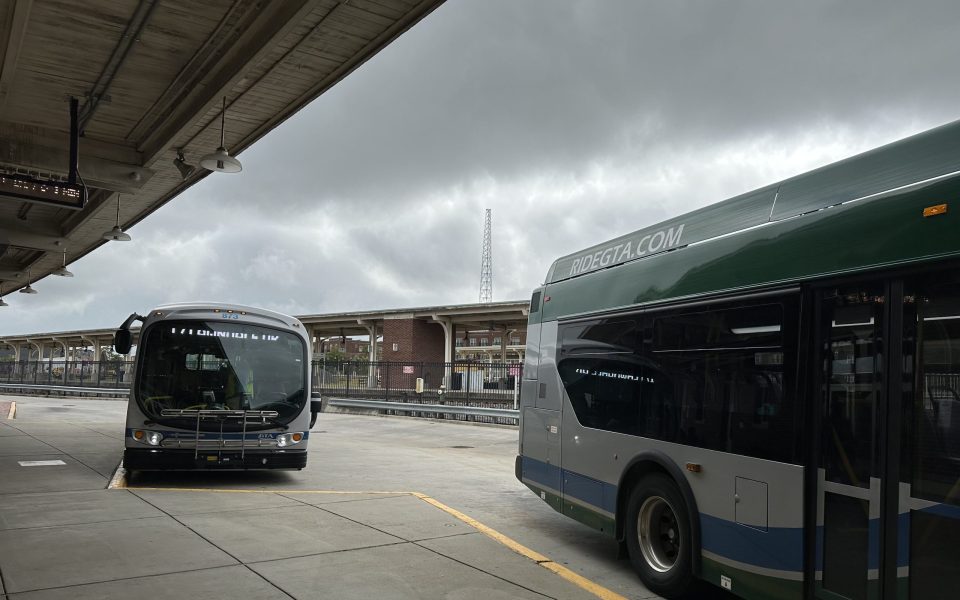Featured photo: Buses parked outside of the bus station in downtown Greensboro (photo by Gale Melcher)
Greensboro is on the road to becoming a car-optional city, and the city wants residents’ input as they make major changes to the Greensboro Transit Agency’s bus routes.
The public-input phase of GoBORO, a long-range public transit plan to make Greensboro a car-optional city, launched on Wednesday.
Inside J. Douglas Galyon Depot, the city’s downtown bus hub, city transit planners presented two concepts that aim to better help residents access jobs and other destinations.
Both concepts include more frequent service and additional GTA bus routes to help travelers reach new parts of the city, but one would allow for wider coverage while the other would focus on making wait times shorter.
The city’s survey asks residents 14 questions such as how often they ride the bus, which transit option they prefer and if they would support increasing transit funding. There will be several opportunities to attend community engagement events from Oct. 1-Nov. 14.
After the public engagement phase, the city will start drafting the network plan this winter. There will be another phase of public engagement in the spring, and the final GoBORO plan will be designed next summer. Residents’ feedback will help city staff understand how to design the final plan based on what is important to the community.
Hanna Cockburn, the director of the city’s department of transportation, said that after community input, the final plan will probably “end up being some blend” of the two plans.
“They’re both important goals — they’re just expressed differently,” Cockburn said.
What are the options?
The city has offered two options: the ridership concept, which would allow for more frequent service in key locations, and the coverage concept, which would focus on bringing more access to areas of the city not currently served by transit.
The existing network currently has 18 routes and a downtown trolley bus route.
The ridership-focused plan would add service routes that residents ride the most, decreasing wait times for most riders. This concept would run bus routes at higher frequencies, resulting in shorter wait times. Seven routes would have fifteen minute wait times, 14 with thirty minute wait times and four with sixty minute wait times.

The coverage concept’s goal is to provide service to as many people as possible. This concept would provide service on more routes, but there would be longer wait times and have far fewer express routes than the ridership concept would.
The coverage-focused plan would extend service a bit further south and northwest than it does now, while both plans would add significantly to western routes.
Three routes would have fifteen minute wait times, 16 would have thirty minute wait times and six with sixty minute wait times.
Some of these routes will combine to provide higher frequency on the same segment.

Efficient routes are important for residents like Don Miller who use the city’s transit services daily. Miller rides the bus to work Monday through Friday. While waiting for his bus at the depot, Miller told TCB that he’s lucky — the route he takes happens to drop him off right at his house.
Right now, 52 percent of residents are within a half mile walk of any transit service. With the ridership concept, that number would rise to 55 percent of residents, whereas with the coverage concept that number would jump to 76 percent of residents.
However, the city currently has no frequent transit service routes that run every 15 minutes. Route 73 is the only route that runs around every 20 minutes — the rest run every 30-60 minutes. With the Ridership Concept, 34 percent of residents would be within a half mile walk of buses that run at a 15-minute frequency. On the other hand, 15 percent of residents would have access to the same if the city goes with the coverage concept.
Council Member Sharon Hightower is leaning towards adding more routes.
“It offers more opportunity and access to jobs that are further on the perimeter of the city because that’s where our growth is right now,” Hightower told TCB.
Hightower serves District 1, located in the east side of the city.
Hightower said that in order to get people who live on the east side to places like the airport where a lot of jobs are springing up, they need to have routes that cover those areas and they need to do it in a “timely way.”
“That’s going to be the challenge,” she said.
Hightower wants the route coverage to open up opportunities for riders, especially in areas where “poverty is the highest and wages are the lowest.”
Scudder Wagg is a public transit consultant with Jarrett Walker and Associates who is working with the city. This transit plan will impact everyone, Wagg said, not just those who ride the bus on a regular basis.
A big driver for the GoBORO plan is access to jobs as the city grows. It opens up access to other amenities like medical services and other businesses.
“That can be transformative for people’s access to opportunity, access to education, access to all sorts of things that will help them,” Wagg noted.
“Two big questions we have for the public at this phase are, do you want to invest and make transit a lot more useful, and how should we invest in it?” Wagg asked.
If Greensboro wants to expand transit significantly, it will require additional funding.
The city would need to hire more drivers in order to bring this plan to fruition. Wagg said that the biggest challenge in transit is that in order to have more frequency, “you need more drivers, more mechanics, more people running the operations.” A half-cent sales tax increase could fund either transit concept, costing the average household about $9 per month.

Either transit concept would cost the same amount, the city’s Transit Director Reginald Mason told TCB. Mason is the city’s first director of the newly created transit department, which now oversees GTA. The city’s department of transportation previously managed GTA.
Mason told TCB that the plan could go into effect in the next 2-3 years, but that they “don’t have a time frame just yet.” After they come back next year with a formal plan, they’ll have to work with elected officials to put funding to increase transit service on the ballot. GTA would receive $27 million from the tax, Mason said.
“There’s no better time than today, except maybe yesterday, to start talking about how we make these investments and what they mean for our community,” Cockburn said, adding that the city would “love to hear from everyone” because this change “should matter to everyone.”
“Even if you’re never going to ride transit, it has a fundamental impact on our community as a whole,” Cockburn said.
Wagg agreed.
“Even if you and your family [aren’t] going to directly benefit,” Wagg said, “your community will be “more economically competitive,” have a “wider range of options for everyone to participate in society.”
Public meetings for the plan are as follows:
- Oct. 1: Art in the Arboretum at the Greensboro Arboretum from 12-5 p.m.
- Oct. 6: GTA ride-along onboard various bus routes
- Oct. 9: Ole Asheboro Neighborhood Association Meeting at Nettie Coad Apartments from 7-8 p.m.
- Oct. 12: Virtual workshop via Zoom from 6-7:30 p.m. RSVP to attend.
- Oct. 21: Ghoulash! Halloween Festival at LeBauer Park from 2:30-5:30 p.m.
- Oct. 24: GoBORO Open House, 11 a.m.-1 p.m. and 4-6 p.m., J. Douglas Galyon Depot
- Nov. 3: First Friday Event with Noches Latinas in LeBauer Park from 6:30-8 p.m.
- Nov. 8: GoBORO Pop Up at the Walmart at Pyramids Village from 2-4 p.m.
- Nov. 8: Music in a Bottle at LeBauer Park from 6-8 p.m.
- Nov. 14: GoBORO Pop Up with the Hopper Trolley at South End downtown on Lewis Street from 11 a.m. to 2 p.m.
All CityBeat reporting content is made possible by a grant from the NC Local News Lab Fund, available to republish for free by any news outlet who cares to use it. Learn More ↗
Republish this storyJoin the First Amendment Society, a membership that goes directly to funding TCB‘s newsroom.
We believe that reporting can save the world.
The TCB First Amendment Society recognizes the vital role of a free, unfettered press with a bundling of local experiences designed to build community, and unique engagements with our newsroom that will help you understand, and shape, local journalism’s critical role in uplifting the people in our cities.
All revenue goes directly into the newsroom as reporters’ salaries and freelance commissions.


Leave a Reply